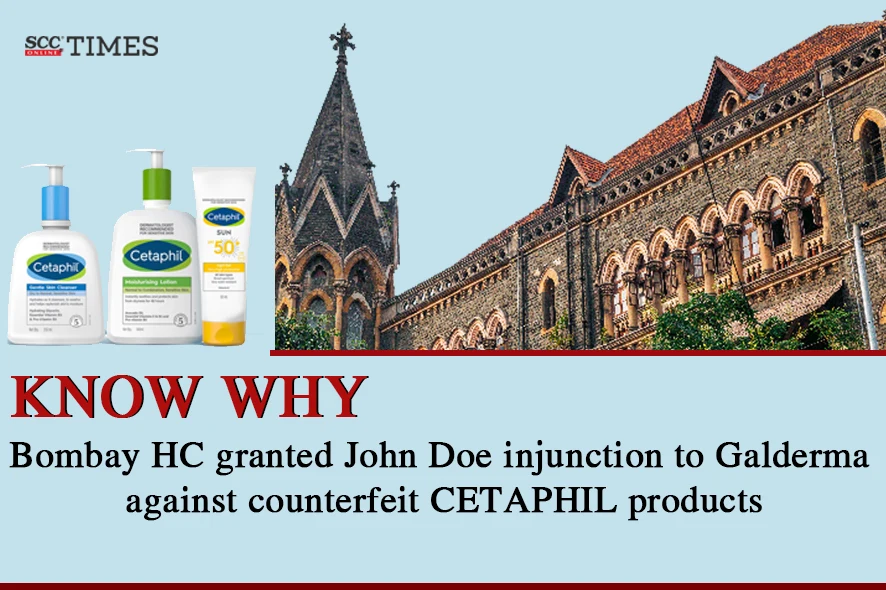Bombay High Court: In an application filed for ad-interim relief, it was alleged by Galderma India Pvt. Ltd. (‘plaintiff’) that the defendants sold goods bearing the plaintiff’s trade mark and artistic work and therefore it sought an injunction to restrain the defendants from doing so. A Single Judge Bench of Sharmila U. Deshmukh, J., opined that upon comparison of the products of the plaintiff and the defendants, it was prima facie evident that the defendants’ products were counterfeit products as it did not contain the barcode, maximum retail price (MRP) etc., which indicated that the same did not originate from the plaintiff and was a slavish copy of the plaintiff’s trade mark and artistic work. Therefore, the Court granted an injunction prohibiting the defendants from infringing on the plaintiff’s products.
Background:
The plaintiff was the proprietor of the registered trade mark “CETAPHIL”. It was submitted that the plaintiff’s product was invented in 1947 and for over 70 years, the products bearing the plaintiff’s trade mark were offered for sale in the market. It was further stated that the plaintiff’s trade mark had a global presence and enjoyed an enormous reputation and goodwill. The artistic work in the said trade mark was also unique with a distinct font of writing and the plaintiff had copyright in the artistic work.
The plaintiff alleged that the Investigation Agency found the infringing goods bearing its trade mark and artistic work, which were counterfeit products, from the defendants who were selling them. The plaintiffs searched on the website of Trade Marks Registry to check if any application was pending for the registration of trade mark similar to that of the plaintiff’s product but failed to find any.
The plaintiff’s counsel wanted to carry on the proceedings in the nature of John Doe action as the manufacturer of counterfeit products could not be identified. He submitted that the adoption of plaintiff’s artistic work indicated a deliberate attempt to come as close as possible to the plaintiff’s product and use the reputation and goodwill of the plaintiff. He further contended that it was not just a case of deceptive similarity but that of counterfeit goods, and that these goods were likely to be sold as plaintiff’s goods. He alleged that there was a likelihood of causing confusion in the minds of average consumers and of wrongful association with the plaintiff.
Analysis and Decision:
The Court took note of the active and leading presence of the plaintiff in the market, which was proved by the sales report and promotional expenses. The plaintiff also produced the Registration Certificates, establishing its proprietary rights. The Court inspected the defendants’ product and saw that it did not bear any manufacturing date or batch number. The Court opined that upon comparison of both the products, it was prima facie evident that the defendants’ products were counterfeit. The counterfeit products did not contain the barcode, maximum retail price (MRP), etc., which indicated that the same did not originate from the plaintiff and were a slavish copy of the plaintiff’s trade mark and artistic work.
The Court observed that it was obvious that the plaintiff’s registered trade mark and artistic work was infringed by the defendants, and it was likely to cause confusion in the minds of the public. The Court further emphasised that unless ad-interim reliefs were granted, the plaintiff would suffer irreparable loss, harm and injury and therefore, the balance of convenience tilted in favor of the plaintiff.
The Court allowed the interim application by the plaintiff and directed that pending the hearing and final disposal of the suit, the defendants were restrained by a perpetual order and injunction from using or causing to be used the plaintiff’s artistic works or trade mark, in relation to the impugned goods or any goods, or in any manner from manufacturing, marketing or offering for sale, advertising or dealing in any such goods so as to infringe upon the plaintiff’s copyright or trade mark.
The Court further ordered that while the suit was pending, a Court Receiver, High Court, Bombay and an Additional Special Receiver at Delhi would be appointed. The defendants were given liberty to apply for variation, modification or recall of this order, after at least seven working days’ notice to the plaintiff’s advocate. The Court listed the matter for 30-7-2025 with the direction that the ad-interim relief would continue till that date.
[Galderma India (P) Ltd. v. M.K. Cosmetics, 2025 SCC OnLine Bom 2590, decided on 18-6-2025]
Advocates who appeared in this case:
For the Applicants/Plaintiffs: Rashmin Khandekar, Smriti Yadav, Shubham Shende, Shubham Singh i/b Khaitan and Co.



